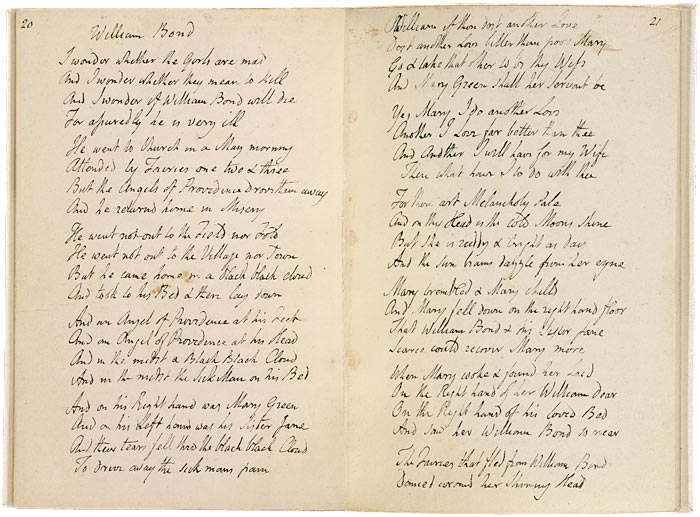
This volume of ten poems in Blake's hand is the unique source for seven of his poetic works, including "Auguries of Innocence."
A dog starved at his master's gate
Predicts the ruin of the state.
The manuscript is named for a previous owner, B. M. Pickering, who acquired it in 1866 and published it for the first time that year. The poems probably date from about 1801 to 1804. As a "fair copy," it shows that Blake had copied all of the poems into a neat form with few corrections. Based on its paper stock and internal references, the manuscript has been dated to about 1807.
I wonder whether the Girls are mad
And I wonder whether they mean to kill
And I wonder if William Bond will die
For assuredly he is very ill
He went to Church in a May morning
Attended by Fairies one two & three
But the Angels Of Providence drove them away
And he returnd home in Misery
He went not out to the Field nor Fold
He went not out to the Village nor Town
But he came home in a black black cloud
And took to his Bed & there lay down
And an Angel of Providence at his Feet
And an Angel of Providence at his Head
And in the midst a Black Black Cloud
And in the midst the Sick Man on his Bed
And on his Right hand was Mary Green
And on his Left hand was his Sister Jane
And their tears fell thro the black black Cloud
To drive away the sick mans pain
O William if thou dost another Love
Dost another Love better than poor Mary
Go & take that other to be thy Wife
And Mary Green shall her Servant be
Yes Mary I do another Love
Another I Love far better than thee
And Another I will have for my Wife
Then what have I to do with thee
For thou art Melancholy Pale
And on thy Head is the cold Moons shine
But she is ruddy & bright as day
And the sun beams dazzle from her eyne
Mary trembled & Mary chilld
And Mary fell down on the right hand floor
That William Bond & his Sister Jane
Scarce could recover Mary more
When Mary woke & found her Laid
On the Right hand of her William dear
On the Right hand of his loved Bed
And saw her William Bond so near
The Fairies that fled from William Bond
Danced around her Shining Head
